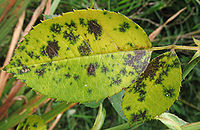- Diplocarpon rosae
-
Diplocarpon rosae 
Scientific classification Kingdom: Fungi Division: Ascomycota Subdivision: Pezizomycotina Class: Leotiomycetes Order: Helotiales Family: Dermateaceae Genus: Diplocarpon Species: D. rosae Binomial name Diplocarpon rosae Diplocarpon rosae is a fungus that causes the rose disease Black Spot.[1] Because it was observed by people of various countries around the same time (around 1830), the nomenclature for the fungus varied with about 25 different names. The asexual stage is now known to be Marssonina rosae while the sexual and most common stage is known as Diplocarpon rosae.
Diplocarpon rosae over seasons as mycelia, ascospores, and conidia in infected leaves and canes. In the spring during moist, humid conditions, ascospores and conidia are wind-borne and rain splashed to newly emerging leaf tissue. Upon infection, disease progresses from the lowest leaves upward causing defoliation and black spots on leaves.[citation needed]
Contents
Diagnosis
The black spots are circular with a perforated edge, and reach a diameter of 14mm. Badly affected plants, however, will not show the circular patterning, as they combine to cause a large black mass. The common treatment of the disease is to remove the affected leaves and spray with anti-fungal solutions. Some stems of the roses may become affected if untreated, and will cause progressive weakening of the rose.
Treatment
Removing infected leaves from the plant and fallen leaves from the ground will slow the spread of the infection, as does avoiding wetting the leaves of plants during watering. An infected plant can be removed from the area, which will slow the spread of infection to other plants, but this often is not desirable. Fungicides, such as mancozeb, chlorothalonil, flutriafol, penconazole, or a copper based product, applied upon new leaf emergence or first appearance of black spot can be used to control the disease. If a more natural and nontoxic approach is desired, diluted neem oil is effective both against black spot and as an insecticide against aphids. It is usually necessary to repeat the spraying at 7 to 10 day intervals throughout the warmest part of the growing season, as the fungus is most active at temperatures from 75 to 90 degrees Fahrenheit.
References
- University of Nebraska page on Black Spot of Rose[1]
- ^ McMaugh, J. What plants pest or disease is that?, New Holland Publishing, Sydney, 2006, ISBN 1864366990, page 231
External links
- Black Spot of Rose at the University of Maine
- Black Spot of Rose at the University of Nebraska-Lincoln
Categories:- Dermateaceae
- Plant pathogens and diseases
- Leotiomycetes stubs
- Plant disease stubs
Wikimedia Foundation. 2010.
